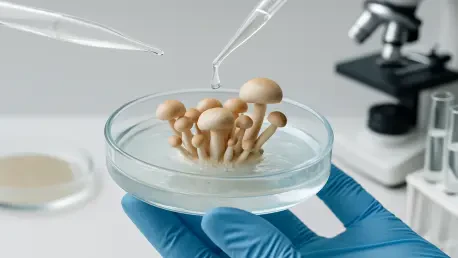Imagine a world where a common soil mold could redefine the future of medical technology, offering solutions for tissue regeneration and flexible medical devices that seamlessly integrate with the human body. A groundbreaking discovery from researchers at a leading university has unveiled the extraordinary potential of a fungus called Marquandomyces marquandii. This seemingly unremarkable organism has the ability to produce hydrogels—materials that absorb significant amounts of water while mimicking the softness and adaptability of human tissue. Such a finding sparks intrigue about how nature’s hidden treasures might address some of the most pressing challenges in biomedical engineering. The implications of this research suggest a shift toward bio-inspired materials that could transform healthcare by providing sustainable, biocompatible alternatives to synthetic options. As scientists delve deeper into the capabilities of this fungal innovation, the promise of revolutionizing medical applications grows stronger, opening doors to uncharted possibilities in healing and device development.
Unveiling Nature’s Hidden Engineer
The journey to this remarkable discovery began with an unexpected twist during a study initially focused on a different fungal species thought to contaminate kerosene. Researchers stumbled upon Marquandomyces marquandii, a soil fungus that exhibited unusual growth patterns, forming thick, multilayered hydrogels with an astonishing capacity to absorb up to 83 percent water. Unlike many fungi that dehydrate easily, this species maintains resilience under stress, showcasing a visible structure with varying porosity. The lead researcher, a Ph.D. candidate in mechanical engineering named Atul Agrawal, noted the intricate design of these hydrogels, which could play a pivotal role in applications like cell scaffolding. This accidental find not only highlights the serendipity of scientific exploration but also underscores the potential for natural materials to solve complex biomedical problems. The unique water-retention and flexibility properties position this fungus as a candidate for creating materials that closely resemble the human body’s own tissues, paving the way for innovative medical solutions.
Further exploration into the properties of M. marquandii revealed its exceptional durability, with hydrogels demonstrating a 93 percent recovery of shape and strength after repeated stress tests. This performance outshines other well-studied fungal species like Ganoderma and Pleurotus, making it a standout in the realm of biological materials. Senior author Steven Naleway, an expert in biological materials for engineering, pointed to the fungus’s robust mycelial layers, primarily composed of chitin—a substance similar to that in seashells and insect exoskeletons. This natural composition hints at biocompatibility, suggesting that these hydrogels could be mineralized into bone scaffolding for medical use. The interconnected structure of the mycelium colony also aids in evenly distributing stress across layers, enhancing the material’s longevity. Such characteristics make it clear that this discovery is not just a scientific curiosity but a potential game-changer for real-world applications in tissue engineering and beyond, where durability and adaptability are paramount.
The Vast Untapped Potential of Fungi
Delving into the broader context of mycology, it becomes evident that fungi remain a largely unexplored frontier in science, with an estimated 2.2 to 3.8 million species worldwide, of which only about 4 percent have been characterized. Mycologist Bryn Dentinger, part of the research team, explained the unique growth mechanism of fungal hyphae—threadlike structures that extend indefinitely with adequate nutrients, forming compartmentalized cells that bolster both strength and flexibility. The accidental identification of M. marquandii after an initial misclassification serves as a reminder of how much there is still to learn about these organisms. This vast, untapped diversity suggests that many more species with unique properties await discovery, potentially offering solutions to a range of scientific and medical challenges. The current research acts as a catalyst, encouraging further exploration into fungal capabilities and their integration into fields like bioengineering, where natural systems could inspire groundbreaking innovations.
Beyond the specific case of M. marquandii, the perspective among researchers is that fungi hold immense promise as structural materials, not just as sources of chemical compounds like penicillin, which has already transformed medicine. Historically, fungi have contributed life-changing advancements, and now, their structural potential is coming into focus. Naleway and collaborators see biological materials like fungal mycelium as bridges between natural systems and synthetic medical solutions, aligning with a growing trend in bioengineering to draw inspiration from nature. The study, published in a prominent journal, reflects a unified understanding that these organisms can address complex human challenges through their inherent designs. As the team pursues patent protection to move from lab experiments to practical applications, confidence in the commercial and therapeutic potential of fungal hydrogels continues to build, signaling a future where nature and technology converge in unprecedented ways.
Pioneering a New Era in Medicine
Reflecting on the strides made, the research into Marquandomyces marquandii marked a pivotal moment in recognizing fungi as more than mere biological curiosities. The ability of this fungus to form resilient, water-absorbent hydrogels that mirrored human tissue properties offered a glimpse into a future where medical treatments became more aligned with natural processes. Its biocompatibility and structural strength stood out as key factors that positioned it as a transformative element in tissue regeneration. The accidental nature of the discovery also illuminated the vast, understudied realm of fungal species, hinting at countless breakthroughs that once lay hidden. As the research team secured pathways for practical implementation through patent pursuits, their efforts underscored a powerful reminder of nature’s capacity to inspire cutting-edge solutions. Moving forward, the focus should shift to accelerating studies on other fungal species, fostering interdisciplinary collaborations, and scaling these innovations for clinical use to fully harness the potential of nature’s designs in reshaping healthcare.









